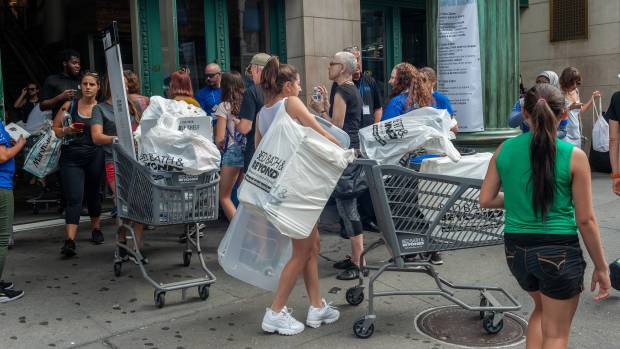
Since embattled home goods retailer Bed, Bath and Beyond filed for bankruptcy in April 2023, many anxiously waited to see whether there would be a last-ditch effort to save the brand, as well as its baby and children's offshoot Buy Buy Baby.
While discounted furniture retailer Overstock.com (OSTK) -) paid $21.5 million for rights to the Bed Bath and Beyond name in June, investors have proven to be less interested in paying big bucks to save Buy Buy Baby.
DON'T MISS: Bed Bath & Beyond Goes Bankrupt
Brand management firm Go Global Retail, which also owns upscale children's clothing company Janie and Jack, was initially in negotiations for the sale of intellectual property rights to keep Buy Buy Baby open.

rblfmr/Shutterstock
'A Difference in Opinion on Valuation'
But as first reported by CNBC, the deal fell through after both sides failed to reach a satisfactory agreement on price.
The children chain's lead creditor, Lender Sixth Street Partners, ultimately decided that it could recoup more losses by selling the rights to the name, selling back the retail leases and liquidating the existing shops.
"We were being fair in our offer," Go Global CEO Jeff Streader told CNBC. "Sixth Street was not unreasonable but there was a difference in opinion on valuation. We wish the IP bid winners success in their journey."
At the end of June, small New Jersey company Dream On Me Industries won the auction for IP rights and online platform for Buy Buy Baby with a bid price of $15.5 million. The crib and other baby furniture maker was one of the former suppliers for Buy, Buy Baby but did not intend to keep the stores open.
Larger companies often buy IP rights to a failed brand to keep for potential future use or prevent competitors from having them.
How a 'Huge Erosion in Value' Sank a Potential Deal
Another person with knowledge of the matter told the news outlet that the "huge erosion of value" in the last six weeks ultimately sank the Buy Buy Baby deal that had been in negotiations for weeks.
While the offer was slightly higher than what was reportedly offered by Dream On Me, it would not have been enough recoup the costs of keeping stores open — to do that, Sixth Street would have had to pour in significant funds at a risky time for both retail and the home-goods sector specifically.
The Bed, Bath and Beyond's Chapter 11 bankruptcy came as a result of dwindling sales and growing debt — after expanding to a peak of 1,500 locations across the country in 2017, the company struggled to remain profitable amid several failed management turnaround attempts and an inability to pivot online quickly enough to meet the growing needs of customers turning that way.
"When they [did go] to shop online, Bed Bath & Beyond wasn't really the first thought in terms of most customers," University at Buffalo Marketing Professor Charles Lindsey once told NBC. "They weren't positioned as strongly as other online retailers."
While the bankruptcy was foreseen well in advance by those in the industry, the strong brand recognition was what dragged out the bankruptcy process and fight for IP rights. Bed, Bath and Beyond launched out of New Jersey in 1971, and during the heyday of malls and brick-and-mortar shopping, was a go-to name for those looking for home goods and furniture.







